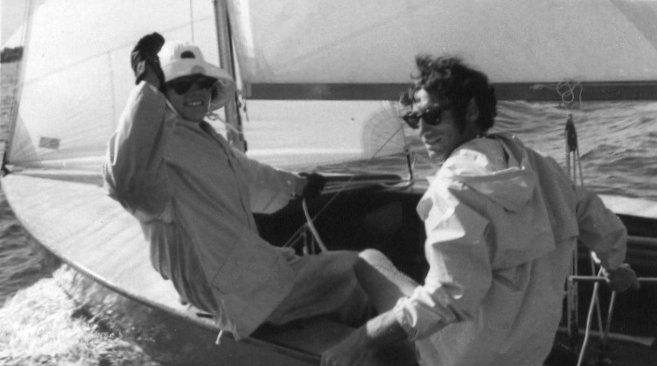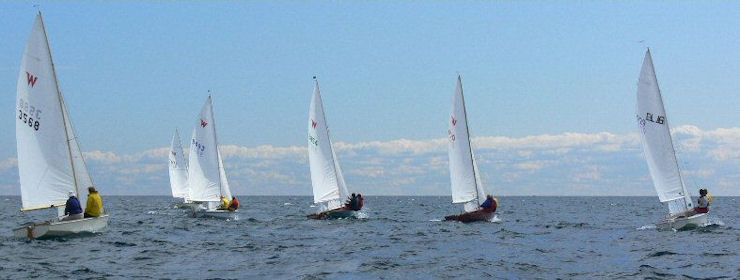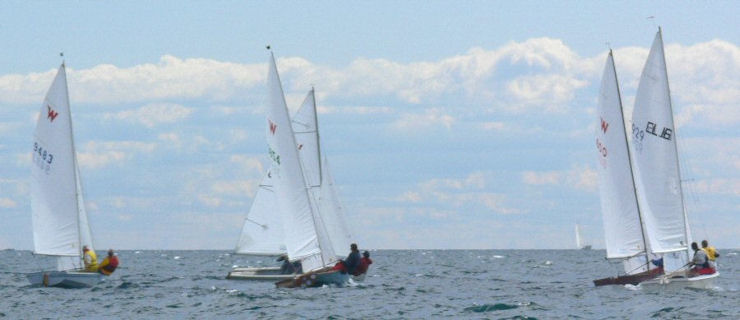| Subject: keen Croatian W raises
centre mainsheet issue > Uncle Al talks main leech tension On 12/6/07, Al Schonborn <uncle-al3854@cogeco.ca>
wrote:
Hi, Mato: Small world! I feel like I already know you, having just this morning read the log of the cruise you did with Ralph this summer. And there, the subject of a centre mainsheet came up. I will give you my short answer first and then add a bit of detail below. I am very much in favour of the centre-only mainsheet system, which is safer for the very reason that you mention: less risk to the gybes. The reason that almost no W's use this system is that it was made illegal in the Class Rules in the mid-1970's - politics, I believe, when the WIC was formed, and the Brits wanted us North Americans to give up one of the rules changes that we had approved but that UKWA had not. Regardless, unless you plan to do serious racing, no one will care if you have a centre mainsheet system. More in green below. Best regards, Uncle Al (W3854) ----- Original Message ----- From: "Mato Ilijic" <mail.mato@gmail.com> To: <uncle-al3854@cogeco.ca> Cc: "Ralph Roberts" Sent: Wednesday, December 05, 2007 7:23 PM Hi Al! My name is Mato, and I began Wayfarering last year. My main interest is day sailing and cruising. Keeping a close eye on your web site, I came across a photo that picked my interest. It's a photo of you in a Wayfarer with centre only mainsheet system (mainsheet not going to the transom at all).  1971 that was, the first year we won the Canadian Nationals. One of my best memories from that year is that three hotshot skippers that had come up from the US were looking at our boat which was tied up in one of the yacht club keelboat slips. My crew, who was going to get more beer from the boat, overheard one of them say, "This shitbox won three races??!!" But I digress. What I really want to point out is that in those days we used a much thicker mainsheet than is necessary: I believe your average new Wayfarer came (comes) with a 3/4 inch (19 mm.) diameter mainsheet which I have come to heartily dislike. 8 mm. is plenty and we on W3854 have no trouble using a 5 mm. diameter mainsheet - click here for details. Such a sheet runs far more easily through its blocks and is thus safer. It is also cheaper to buy and can be used with smaller blocks. I'm interested in this solution because I hate it when the mainsheet gets caught under the rear corner of the boat in a gybe. That is definitely a problem, especially with glass W's. Over here in Canada, some guys cut out bottom corners of a large square plastic jug and fit one over each corner of the transom. I am told that this prevents the sheet from catching. But, from documents on your web sites, I also understood the advantages of a transom bridle, and the benefit of not exerting excessive downward pull on the sail. These are very small advantages. The thing I actually like best about the bridle is that I can easily see how close to "block to block" I am sheeting, i.e. I can easily see whether I am 2 or 4 cm. from being "block to block" (i.e. the distance between boom and bridle block > block to block = zero cm. between these). In other words I can remember and duplicate settings more easily. But this is for serious racing only!! Since you obviously have experience with both systems, I would be grateful if you could share with me your opinion on the matter. I suppose that the biggest difference in performance between the two systems, is on a close hauled course. Yes. How would you compare the centre-only boat's performance to the bridle boat's in such a situation - in terms of angle towards the wind and speed? If it's only a minor difference, then I would really prefer the centre-only system for cruising. The difference in upwind potential is less than minor. The boat should be able to point just as well with a centre mainsheet system as with any other system. The real difference is made by mainsail leech tension. Mike McNamara once told me, "You point off your mainsail leech." After nearly 40 years of racing, I was surprised by this, since one instinctively thinks of the jib as creating the pointing. I still am not quite sure why it works, but I do know that it does! In this year's Chesapeake Bay Cruise, I saw an extreme example of this: see our pictures from the day we had a four-hour beat to Tangier Island. About halfway down that page, you can see that some of our guys sailed with the top of the mainsail twisted off to leeward while closehauled. This looks pretty but is slow!! On our boat, we put on lots of boom vang (North American for "kicker") to keep the mainsail leech tight even when we eased the main out to keep the boat from heeling too much. The rule of thumb is that your top batten should be parallel to the boom. So, you sheet in - regardless of the system you use, until the top batten is properly aligned with the boom. And if there's more wind than you can hike down, you tension the vang, such that when you ease the mainsheet to spill wind, the upper batten still remains parallel to the boom. The other guys on our cruise were letting their mains twist off too much and we outpointed them to the extent that, three or four times, we ended up so far ahead, that we hove to and had a beer while we waited for them to catch up. All this without our working hard or hiking: the whole difference was mainsail leech tension!! There are other small subtleties but they would take too long to discuss and only confuse the issue. One item is worth mentioning however: in very light winds, the weight of the boom will make the mainsail leech hook to windward, in which case I modify my batten rule to read: top batten parallel to the centre line of the boat, i.e. in drifters, I sail with the boom end out more or less over the corner of the transom, which gets my top batten about parallel to the centre line of the boat. To illustrate the point about avoiding too much mainsail twist, I can give you two pictures from the regatta for which I am just doing the photos text. These pics were taken from the committee boat a few moments after the start:    Not necessary, I think!! Best regards, Mato Ilijic W10435 - Pinčika Croatia P.S. While sailing with the centre-only system, did you ever feel that the increase of force exerted on the swivelling block was beyond or close to the limit of its designed tolerances? No. But make sure you have the swivel block attached to something good and solid, since as you say, it will be taking more load! (Al's note: here I suggested separate blocks on the boom but Mato pointed out why this would not work, and suggested that to spread the load on the boom, a T-bar might be advisable - see Mato's reply below) We cleat our mainsheet all the time, even though books tell you not to. It's too much work to hold the sheet all the time and the argument can be made that a tired sailor will make (more) mistakes. In tricky conditions, I do however, always have the sheet in my hand. If a gust hits, I can have the main uncleated faster than the wind can make the boat heel, no problem! Hope this has helped, Mato. Do feel free to stay in touch, and let me know if I can help in any other way. ----- Original Message ----- From: "Mato Ilijic" <mail.mato@gmail.com> To: "Al Schonborn" <uncle-al3854@cogeco.ca> Cc: "Ralph Roberts" Sent: Thursday, December 06, 2007 8:47 AM Hi Al! Thank you very much for your reply! It makes things much more clear to me, and also makes me more confident in switching to centre-only system. I've already done a decent amount of mathematics to analyze the relationship between downward and sideways component of sheet tension in various systems. But, sailing with Ralph I learned that usually with boats, practice proves much more valuable than theory. I'm happy I can forget all those formulas, geometry and ratios now, and just go ahead with the change with piece of mind. Best regards, Mato P.S. I'm curious about the whole politics/negotiations which led to the forbidding of this system in the rules. Perhaps enough time has passed since than, so if you remember the story, maybe you could share it... Just one more thing on the centre-system in case you intend to put the story on web site: I'm afraid it wouldn't work to install a fiddle block on a cleat base, and have two blocks on the boom apart. If we imagine the boat on a broad reach, or sailing downwind, then the plane in which the sheet travels from the becket on the fiddle block up to the boom to the first block, then down to the fiddle and up again to the second block on the boom - this plane would not be the same as the plane in which the sheet travels from helm's hand to the fiddle and up to the boom. I think there would be some friction because the sheet would try to twist the fiddle block. If we feel that the transfer of the force into a single point on the boom is risky, than one could make a metal T-shaped slide (about 20 or 30 cm long) which would be inserted into the boom track. This metal slide could then hold the boom-side blocks and distribute the pressure along wider strip of the boom. Am I wrong perhaps with this? I won't be able to sail before spring/summer so my first opportunity to test it will not be very soon unfortunately. Best regards, Mato -----
Original Message -----
From:
Al Schonborn
To:
Mato Ilijic (W10435)
Cc:
Ralph Roberts
Sent:
Thursday, December 06, 2007 1:15 PM
Just a quick note since I'm getting ready for a new computer tonight and so will be off duty for the next day or so, trying to get it all set up. Glad the answer was what you wanted to hear. Nothing prevents us from raising the centre mainsheet idea these days, but for me, it's a low priority item. I like my present system and would say that the cruising sailors would be the most interested - and they are not really subject to our Class Rules in any case. Read your second email, too, and agree that you'd need to go with the t-bar ideas if boom strain is a concern - and I'm not an expert in that field (to put it mildly!!) Talk to you soon, Uncle Al (W3854) ... and a heart-warming comment on all this from Mato's cruise partner, Ralph Roberts (W9885):
|